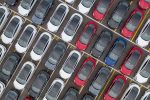
New Porsche Taycan Beats Tesla Model S Plaid with 7:07 Nurburgring Lap Record
Porsche has once again demonstrated its prowess in the electric vehicle realm with the latest iteration of the Taycan, shattering records at the Nurburgring. The German automaker has yet to unveil the official name or disclose specific performance details of its new creation. However, one thing they proudly announced is the remarkable lap time achieved by a ‘pre-series Taycan’—a staggering 7 minutes and 7.55 seconds.
This achievement not only positions the mysterious Taycan variant as the fastest electric Porsche around the iconic Nurburgring but also eclipses the previous record held by the Tesla Model S Plaid, beating it by an impressive 17.681 seconds. The undisclosed model’s lap time is 26 seconds faster than the current Taycan Turbo S, edging remarkably close to the Rimac Nevera’s 7:05.298 record.
While Porsche remains tight-lipped about the car’s specifics, speculations are circulating that it might be dubbed the Taycan Turbo GT. Rumors suggest a formidable tri-motor drivetrain boasting around 1,000 horsepower, with an additional motor on the rear axle not only enhancing thermal management but also introducing advanced traction control techniques.
The vehicle showcased at Nurburgring did receive some modifications to enhance safety and track performance. Notably, racing bucket seats and a roll cage were added, underlining the dedication to both speed and safety.
Enthusiasts can anticipate more information in mid-March when Porsche plans to release a video of the record-breaking lap. This unveiling might coincide with details about the car itself and potentially a mid-cycle refresh for the broader Taycan range.
The speculation extends to potential upgrades in the powertrain, questioning whether a new battery or alterations in cell chemistry are part of the equation. Silicon carbide inverters are also on the radar, as Porsche has hinted at incorporating this technology into the new electric Macan, aiming for more efficient operation at higher sustained currents—crucial for demanding tracks like the Nurburgring.

